CTAL-TA_Syll2019 iSQI ISTQB Certified Tester Advanced Level - Test Analyst (Syllabus 2019) Free Practice Exam Questions (2025 Updated)
Prepare effectively for your iSQI CTAL-TA_Syll2019 ISTQB Certified Tester Advanced Level - Test Analyst (Syllabus 2019) certification with our extensive collection of free, high-quality practice questions. Each question is designed to mirror the actual exam format and objectives, complete with comprehensive answers and detailed explanations. Our materials are regularly updated for 2025, ensuring you have the most current resources to build confidence and succeed on your first attempt.
Consider the following state diagram for a simple ATM.

The decision has been made to add the following capabilities:
Allow the customer to go from Get Balance to Deposit, Withdrawal or Menu.
Allow the customer to go from Deposit to Withdrawal, Get Balance or Menu
From Withdrawal the customer still will be able to go only to Menu.
How many test cases are required to achieve 100% 0-switch coverage of the new and existing capabilities?
As a Test Analyst on a project using the V-model lifecycle model, you have been working with expert business users for a program designed to assist car buyers in selecting options for new car models. The program has been in use for some time, and now your company has decided to implement some significant improvements, based on customer and sales representative's feedback.
You visit specific locations and gather information on how the product is currently being used, spend time with expert users, and walk through their envisioned scenarios.
Based on this information, what are you using for your test basis and what information is still missing?
In the recent past, you have learned that test automation just using capture & playback tooling, possibly enhanced with some test programming, has limitations. For the next banking project, that will be run using Agile methods, you want to implement a keyword-driven test automation approach. You have already started to define some high-level test cases for the account transfer user story:
TC 1 transfer € 150 from Lars to Ann, verify Ann's balance to be € 150
TC 2 transfer € 300 from Tim to Ann, verify Ann's balance to be € 450
In the context of implementing the keyword-driven test automation approach, which of the following activities should now be conducted by the Test Analyst?
In the initial release of an insurance risk assignment application, a variety of test techniques were employed, especially equivalence partitioning.
After a thorough root cause analysis of this release, it was determined that the developers tended to incorrectly use ">" and "<" rather than the ">=" and " <= " in the code at several decision points.
This caused several borderline cases to be handled incorrectly.
Based on this analysis, how would you modify your test strategy for the next version's release?
